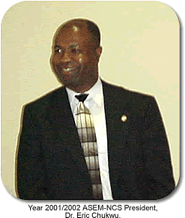Two guest speakers presented the FUSRAP Program at the June luncheon meeting of the American Society for Engineering Management's National Capital Section. The speakers were Mr. James Owendoff from the Department of Energy (DOE), and Mr. Larry Camper from the Nuclear Regulatory Commission (NRC).
Mr. Owendoff is the Principal Deputy Assistant Secretary for Environmental Management at DOE. He is responsible as the leader of large nuclear/hazardous waste management and environmental clean-up programs, which include treatment of waste, risk reduction, and developing new technologies.
Mr. Camper is a member of the Senior Executive Service (SES) with the NRC. He is currently serving as the Chief of the Decommissioning Branch. He was previously the Chief of the Materials Safety and Inspection Branch, Division of Industrial and Medical Nuclear Safety. Mr. Camper has been invlved in various regulatory policy issues in the decommissioning of nuclear facilities.
The Formerly Utilized Sites Remedial Action Plan (FUSRAP) Program was initially developed in 1974 by the Atomic Energy Commission (AEC) to assess sites that were radiologically contaminated and to find appropriate remedial solutions. FUSRAP was managed by DOE (the successor agency to the AEC). The program was then transferred to the U.S. Army Corps of Engineers (USACE) by way of the FY 1998 Energy and Water Appropriation Bill. On March 17, 1999, DOE and USACE established a Memorandum of Understanding (MOU) in order to determine roles and responsibilities and better implement the FUSRAP program. This was followed by another MOU, this time between the USACE and NRC on July 5, 2001. The goal of this second MOU was to minimize dual regulation and to facilitate the decommissioning of FUSRAP sites that were NRC-licensed.

Mr. Camper indicated that the MOU would be applicable to sites formerly licensed by the NRC in order to meet the decommissioning requirements of 10 CFR 20 Subpart E ("Radiological Criteria for Unrestricted Use"). He also noted that the MOU would not apply to sites that were going to be decommissioned with restrictions on future site use. Mr. Camper said that the responsibilities of the NRC under the MOU would include suspending the NRC license at FUSRAP sites during the remediation activities (under CERCLA) of the USACE, reviewing/commenting on the decommissioning plan, monitoring USACE activities and terminating the license after verifying that the site remediation is completed.
Mr. Camper pointed out several challenges with the FUSRAP program: gaining interest at the congressional and state levels, the timeline for remediation and licensee financial assurance vs potential responsible party.
Mr. Camper concluded his speech by noting the benefits of the FUSRAP program. He said that the program was a formal mechanism that avoided dual regulation. He also indicated that FUSRAP enhanced the cooperation between agencies during the remediation activities of complex sites, which in turn gave safer, faster, better and cheaper results and established a model for other interagency complex site remedial programs.
Mr. Owendoff talked about the land management, transfer, and long-term stewardship activities at DOE. He gave examples of the limited number of sites that had been sold and/or leased for continued industrial use.He said that DOE was working with the USACE to allow the transfer of sites cleaned-up under FUSRAP. He also indicated that 80% of DOE's sites are not contaminated and that the largest sites are in sparsely populated areas with low land values. Mr. Owendoff noted that DOE will have continuing missions at over 20 sites currently undergoing clean-up.

More details on the MOU for the FUSRAP program can be found in the Federal Register, Volume 66, No 134/Thursday, July 12,2001 (66 FR 36606) or at the website.
The June meeting was the last meeting for the 2001/2002 year for the National Capital Section of ASEM. Therefore, new officers were elected:
- Andrew Lue, President
- Ed Hagarty, Vice President
- Elvin Yuzugullu, Program Chair
- Lynn Bechthold, Secretary/Treasurer
- Amir Kouhestani, Membership Chair



